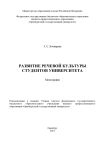Текст книги "Международная молодежная научная школа «Школа научно-технического творчества и концептуального проектирования»"

Автор книги: Коллектив Авторов
Жанр: Прочая образовательная литература, Наука и Образование
сообщить о неприемлемом содержимом
Текущая страница: 3 (всего у книги 19 страниц) [доступный отрывок для чтения: 6 страниц]
СОЗДАНИЕ НАУЧНЫХ СТУДЕНЧЕСКИХ ОБЪЕДИНЕНИЙ ПРИ ВУЗЕ, ОРИЕНТИРОВАННЫХ НА КОММЕРЦИАЛИЗАЦИЮ РЕЗУЛЬТАТОВ ИНТЕЛЛЕКТУАЛЬНОЙ ДЕЯТЕЛЬНОСТИ
Шилов А.С., Фокин А.А
ФГБОУ ВПО «Сыктывкарский государственный университет», г. Сыктывкар, Российская Федерация, [email protected], [email protected]
В настоящее время, все большее внимание со стороны государства и общества уделяется модернизации и развитию инновационных технологий, в нашей стране действует множество различных федеральных и региональных программ, направленных настимулирование роста инновационных технологий в приоритетных направлениях для Российской Федерации [Указ Президента РФ от 7 июля 2011 г. N 899 «Об утверждении приоритетных направлений развития науки, технологий и техники в Российской Федерации и перечня критических технологий Российской Федерации» [Электронный ресурс – www-документ] URL: http://text.document.kremlin.ru/SESSION/PILOT/main.htm].
Основным поставщиком инноваций являются вузы и научные учреждения, в них сосредоточена львиная доля инновационного потенциала страны. Соответственно студенты и молодые ученые – это «двигатель» научно-технического прогресса, и к которым, без сомнения, должно быть уделено соответствующее внимание со стороны государства и бизнес сообществ. Обратимся к зарубежному опыту, последнее десятилетие XX века в США ознаменовалось массовым появлением конкурсов инновационных проектов. Формирование венчурного рынка, с одной стороны, обусловило интерес фондов к новым проектам, а с другой – превратило предпринимательскую активность студентов в один из ключевых факторов конкурентоспособности вузов. В частности, с 1998 года под эгидой знаменитого Массачусетского технологического института (Massachusetts Institute of Technology, MIT) проводится всемирный семинар стартапов Global Startup Workshop (GSW), который стал флагманом в мировой практике студенческого предпринимательства. Одним из важнейших нематериальных активов MIT является особая творческая среда, которая существенно отличается от атмосферы, царящей до сих пор в большинстве Российских вузов. Помимо учебы и выполнения самостоятельных заданий, студенты постоянно участвуют во множестве мероприятий и программ, которые проходят в течение года [Инновации: ключ на старт. Экосистема венчурных компаний посевного цикла: состояние и перспективы [Текст] / ООО Наутех, коллектив авторов. М.: Бизнес-журнал, ИД Компьютерра, 2010. – 228 с.].
В современной реальности, для коммерциализации результатов НИОКР (R&D), просто необходимо использовать те возможности, которые предоставляются молодежи, но для этого в процессе учебы студентам вузов необходимо создавать условия, способствующие их развитию в направлении инновационного предпринимательства в приоритетных научных направлениях, но проблема в том, что работа в этом направлении в Российских вузах идет медленно, особенно в региональных. В данной статье предложен пример создания научных студенческих объединений, студенческих научно-исследовательских лабораторий, которые, прежде всего, ориентированы на коммерциализацию результатов интеллектуальной деятельности, такие лаборатории могут успешно создаваться при малых инновационных предприятиях, которые функционируют при вузе. В подавляющем большинстве случаев научные исследования проводимые студентами, в рамках образовательной программы вуза, не коммерциализуются, а причина в том, что изначально не ставится такой цели, в таком случае используется принцип – наука ради науки. Студентам, помимо научно-исследовательской деятельности, необходимо получать бизнес-компетенции, необходимые для становления инновационных проектов, и перехода от этапа научной разработки до появления коммерческого продукта или услуги. Положительным примером может служить студенческая научно-исследовательская лаборатория «Sport & Health» Сыктывкарского государственного университета, которая в настоящее время реализует несколько инновационных проектов, участвует в различных конкурсах и программах («УНИК», «СТАРТ», Зворыкинский проект и т.д.) причем для данного вуза, такая практика обучения инновационного предпринимательства является новой. Такой подход позволит привлечь заниматься инновациями активных, целеустремленных студентов, что в будущем позволит благотворно воздействовать на инновационную инфраструктуру региона.
НАПРАВЛЕНИЕ 2
НАУЧНО-ТЕХНИЧЕСКОЕ ТВОРЧЕСТВО СТУДЕНТОВ И МОЛОДЫХ УЧЕНЫХ

2.1 ТЕХНОЛОГИЯ СОЗДАНИЯ И ОБРАБОТКИ ПОЛИМЕРОВ И ЭЛАСТОМЕРОВ
THE OXIDATION OF SODIUM SULFIDE USING TRANSITION METAL OXIDES DEPOSITED ON THE POLYMER MATRIXBui Dinh Nhi, Akhmadullin R.M, Akhmadullina A.G., Samuilov Y.D.
Kazan National Research Technological University, [email protected]
Kazan is a large center of the Russian chemical industry. Production of polysulfide rubbers and hermetics occupy a special place in Kazan. In 2000 production of polysulfide hermetics for double-glazed windows was organized.
Thiocol production is extremely adverse in the ecological relation. It is well known that the odors from thiocol production are obnoxious. Many methods for eliminating Na2S have been reported due to industrial need. There will be some problems, however, if these methods are applied to wastewater treatment. The most interesting method of sodium sulfide detoxification is the oxidation of the toxic sulfur compounds in the waste by the use of atmospheric oxygen. In the absence of catalysts, this process is performed at temperatures of 90-110 0C and pressures of 0.3-0.5 MPa. The use of catalysts can give a significant acceleration of the oxidation process, so that it can be performed at 40-50 0C. Homogeneous catalysts, including transition metal oxides can dissolve in alkaline solution. Heterogeneous catalysts were synthesized by introducing transition metal oxides into the polymer matrix. The heterogeneous catalyst has a high level of chemical stability, mechanical strength, and stable catalytic activity.
In this paper is proposed the catalytic efficiency of transition metal oxides deposited on the polymer matrix in the sodium sulfide oxidation and investigation of kinetic parameters in presence of copper and manganese oxides catalyst.
The effect of transition metal oxides deposited on the polymer matrix in the sodium sulfide oxidation is given in Figure 1.

Fig. 1 The effect of transition metal oxides deposited on the polymer matrix in the sodium sulfide oxidation.
It is apparent from the Figure that copper and manganese oxides show maximum activity in the sodium sulfide oxidation, in this case intial rate of reaction is, respectively, about 1,4 and 1,35 times higher than intial rate of no catalyst. Oxides of NiO, Co3O4, Cr2O3, TiO2 – show insignificant activity, a part from the tested oxides: V2O5, Fe2O3 – don't influence rate of reaction, and catalysts based on the MoO3 oxide– even inhibit sodium sulfide oxidation.

Fig. 2 The effect of mixed compositions by different concentration of copper and manganese oxides in the sodium sulfide oxidation.
Catalytic activity of mixed compositions, which were synthesized by different concentration of copper and manganese oxides shows that CuO5/MnO2-15 possesses highest activity for sodium sulfide oxidation (Fig. 2).
Influence of the heterogeneous catalyst amount on the rate of reaction shows that increasing catalyst amount to 5,0 g leads to increase the rate of sodium sulfide oxidation. The further increases in catalyst amount don't influence rate of reaction (Fig. 3).

Fig. 3 Influence of the heterogeneous catalyst amount on the rate of sodium sulfide oxidation

Fig. 4 Influence of temperature on the rate of sodium sulfide oxidation
Influence of temperature on the rate of reaction shows that the maximum rate of sodium sulfide oxidation is observed at temperature 600С, above and below 60 0С rate of reaction is decreased (Fig. 4).
Kinetic methods show that all reactions are first order with respect to the [O2] and zero – to the concentration of sulfur compounds (Fig. 5).

Fig. 5 Logarithmic dependence of rate of sodium sulfide oxidation on concentration О2
IMIDAZOLIUM BASED POLYMERIC IONIC LIQUIDS AS POLYMER ELECTROLYTE MEMBRANES
Hamit Erdemi
Department of Polymer Engineering, Faculty of Engineering, Yalova University, TR-77100 Yalova, Turkey, [email protected]
Ionic liquids are defined as molecules containing a permanent charge and a melting point below 100 oC [1]. Although it is not a requirement, in general, the more common ionic liquids possess an organic cation and an inorganic anion. Ionic liquids are receiving an upsurge of interest for their unique physicochemical properties such as high thermal stability, negligible vapor pressure, relatively high ionic conductivity, and good electrochemical stability.
Ionic liquids have also been quite popular recently due to their potential application as green chemical reaction solvents and water treatment agents. The permanent charge provides many useful applications, such as electroactive devices and actuators. They serve as charge exchange films in electroactive devices or ionic liquids and can be used to improve existing films upon swelling, which leads to enhance the conductivity of the actuator.
Solid electrolytes play an important role in the development of new energy sources, like solid state batteries, fuel cells, photoelectrochemical solar cells, sensors and electrochromic displays [2,3]. Obtaining high ionic conductivity over a wide temperature range becomes crucial for the realization of these technological applications. Traditional ion-conducting polymers such as poly(ethylene oxide) – based polymer electrolytes, are solid solutions of salts in polymers [4-7]. Ionic motion in these polymer electrolytes is coupled with the local segmental motion of the polymer. In this type of electrolytes an increase of carrier-ion density and mobility are difficult to achieve because both, depend on the interaction of polymer segments with the ions. Various research groups [8–11] have been involved actively to synthesize polymer electrolytes with high conductivities, but up to now the desired conductivities, particularly at high temperatures, have not been attained. Hydrated perfluorosulfonic polymer shows superior performance in fuel cells operating at moderate temperature (<90 ◦C), however, the properties of such polymer membranes are insufficient at higher temperatures. This puts new demands on the development of alternative polymeric proton exchange membranes [12]. Based on this concept, the use of ionic liquids appears to be promising with respect to high ion conductivity in polymers. Due to an ionic liquid’s ability to facilitate electron or ion motion, they are now enabling electroactive devices. Commercially available conductive membranes are swollen with ionic liquids to enhance their conductivity; alternatively, conductive membranes are synthesized from novel ionic liquid monomers, also termed polymerizable ionic liquids. The imidazole ring has gained much attention for its ability to tune the properties of the resulting ionic liquid. The imidazole ring is a very versatile scaffold for ionic liquids. The ring is easily ionized upon quaternization of the tertiary nitrogen atom, resulting in a permanent positive charge. A unique combination of various alkyl substituents and counteranions enables tuning of the physical properties of the liquid such as the melting point, the boiling point, and the viscosity to meet the demands of the application. The structure is uniquely tunable because of the inherent amphoteric behavior, i.e. the imidazole ring both accepts and donates protons. Finally, the imidazolium cation is associated with a mobile counteranion, which can be exchanged to further tune solubility and conductivity [13].
1. Visser, A. E., Swatloski, R. P., Reichert, W. M., Mayton, R., Sheff, S., Wierzbicki, A., Davis, J. H., Rogers, R. D. Environ. Sci. Technol. 2002, 36 (11), 2523–2529.
2. F.M. Gray, Solid Polymer Electrolytes, VCH, New York, 1992.
3. A.M. Anderson, C.G. Granquist, J.R. Stevens, Appl. Opt. 28 (1989) 3295.
4. M.B. Armand, Ann. Rev. Mater. Sci. 16 (1986) 245.
5. C.A.Vincent, Prog. Solid State Chem. 17 (1987) 145.
6. M.Watanabe, N. Ogata, Br. Polym. J. 20 (1988) 181.
7. M.A. Ratner, D.F. Shriver, Chem. Rev. 88 (1988) 109.
8. D.E. Fenton, J.M. Parker, P.V. Wright, Polymer 14 (1973) 589.
9. M.B. Armand, J.M. Chabagno, M. Duclot, 2nd International Conference on Solid Electrolytes, St. Andrews, 1978, p. 651.
10. C.A. Bruce, P.G. Vincent, Trans. Faraday Soc. 89 (1993) 3187.
[11] G.B. Appetecchi, F. Croce, B. Scrosati, J. Power Source 66 (1997) 77.
12. O. Savadogo, J. New Mater. Electrochem. Syst. 1 (1998) 47.
13. Marcilla, R., Blazquez, J. A., Rodriguez, J., Pomposo, J. A., Mecerreyes, D. Journal of Polymer Science Part A: Polymer Chemistry 2004, 42 (1), 208–212.
BIODEGRADABLE POLYMERS FOR TISSUE ENGINEERING APPLICATIONSKadriye Tuzlakoglu
Department of Polymer Engineering, Faculty of Engineering, Yalova University, TR-77100 Yalova, Turkey, [email protected]
Tissue engineering is an interdisciplinary field that blends classical engineering and the life sciences to repair or replace damaged tissues. The most common strategy to achieve this goal is to culture of patient’s own cell onto a three dimensional support matrix, so called scaffold, and then implant this construct to the patient. The function of a degradable scaffold is to act as a temporary support matrix for transplanted or host cells so as to restore, maintain, or improve tissue. The design of a polymeric scaffold plays a significant role in proper cell growth. Therefore, several important properties must be considered: fabrication, structure, biocompatibility, biodegradability, and mechanical strength.
Scaffolds may be created from various types of materials, including polymers. There are two sources of polymers used in tissue engineering: synthetic and natural. The main biodegradable synthetic polymers include polyesters, polyanhydrides, polyorthoesters, polycaprolactone, polycarbonate, and polyfumarate, while the natural origin polymers include collagen, alginate, agarose, hyaluronic acid derivatives, and chitosan. Among the man-made polymers, polyglycolide, polylactides, poly(caprolactone), and poly(dioxanone) constitute the major polymer groups that have been studied as matrix materials.
Natural polymers are typically biocompatible and enzymatically biodegradable. The main advantage for using natural polymers is that they contain bio-functional molecules that aid the attachment, proliferation, and differentiation of cells. However, disadvantages of natural polymers do exist. Depending upon the application, the previously mentioned enzymatic degradation may inhibit function. Further, the rate of this degradation may not be easily controlled. Since the enzymatic activity varies between hosts, so will the degradation rate. Therefore it may be difficult to determine the lifespan of natural polymers in vivo. Additionally, natural polymers are often weak in terms of mechanical strength but cross-linking these polymers have shown to enhance their structural stability.
Polymers that are chemically synthesized offer several notable advantages over natural-origin polymers. A major advantage of synthetic polymers is that they can be tailored to suit specific functions and thus exhibit controllable properties. Furthermore, since many synthetic polymers undergo hydrolytic degradation, a scaffold’s degradation rate should not vary significantly between hosts. A significant disadvantage for using synthetic polymers is that some degrade into unfavorable products, often acids. At high concentrations of these degradation products, local acidity may increase, resulting in adverse responses such as inflammation or fibrous encapsulation.
There are several methods to produce 3D scaffolds from polymers, such as particulate leaching combined with compression moulding or solvent casting, freezing drying, fiber bonding, electrospinning and rapid prototyping, etc.
Particulate leaching is an inexpensive method based on dispersing certain size particles within a polymeric solution or fine polymer powder and then moulding this mixture by solvent casting or compression moulding techniques. The final porous stucture is achieved by removal of porogen from polymeric construct.
Freeze-drying is the most common and simple method to produce scaffolds, especially from natural polymers. The scaffolds, with different pore size and porosity, can be formed by the simple procedure of freezing a polymer solution in a suitable mould and subsequently lyophilizing the frozen structure. The freezing process provides the nucleation of ice crystals from solution and further growth along the lines of thermal gradients. Ice removal by lyophilization generates a porous material.
Fiber-based scaffolds can be obtain with fiber bonding followed by commercial fiber production methods, such as melt spinning, dry spinning and wet spinning.
Electrospinning is a relatively simple and efficient method to produce polymeric fibers on a nano scale. It has been used in polymer processing technology for more than 70 years and recently had much attention from the biomedical field, particularly in tissue engineering due to the structural properties of fabricated fibrous structures having diameters in the range close to the collagen fibers found in the natural extracellular matrix of about 30–130 nm.
Rapid prototyping is a common name for a group of techniques, such as fused deposition modeling (FDM), laminated object manufacturing (LOM), three-dimensional printing (3DP), multiphase jet solidification (MJS) and 3D plotting, that can generate a physical model directly from computer aided design data. It is an additive process in which each part is constructed in a layer-by-layer manner. This technology allows one to produce a complex 3D structure of scaffolds with controlled architecture which means desired pore size, porosity and pore distribution.
POLYMER/CLAY NANOCOMPOSITES BY IN SITU METHODSMehmet Atilla TASDELEN
Department of Polymer Engineering, Faculty of Engineering, Yalova University, TR-77100 Yalova, Turkey, [email protected]
Polymer/clay nanocomposite materials, in which nano-sized silicate plates of clay are uniformly dispersed in the polymer matrix, exhibit superior physical properties such as high dimensional stability, gas barrier performance, flame retardancy, and mechanical strength that cannot be achieved by pure polymer or conventional composites (micro– and macro composites) [1-3]. Furthermore, polymer layered silicate nanocomposites (PLS) avoid processing techniques (e.g. extrusion) which are used for materials with a higher content of reinforcement. This polymer/clay nanocomposites can be prepared in several ways, namely, solution exfoliation, melt intercalation, in situ polymerization and template synthesis [4]. Solution exfoliation can be only used with water-soluble polymers to produce mostly intercalated nanocomposites, because of the need of large amounts of solvent to ensure a good clay dispersion [5]. Melt intercalation is a solvent-free method which enables mixing of the layered silicate with the polymer matrix in the molten state. However, very careful attention has to be paid to finely tune the processing conditions to increase the compatibility of clay layer surfaces with the polymer matrix. In the in situ polymerization technique, the monomer, together with the initiator and/or catalyst, is intercalated within the silicate layers and the polymerization is initiated by external stimulation such as thermal, photochemical or chemical activation [6-10]. The chain growth in the clay galleries triggers the clay exfoliation and hence the nanocomposite formation. Unlike melt intercalation, the low viscosity of the monomer (if compared with the polymer) in the in situ polymerization makes it more easy to break up particle agglomerates by using high shear devices, resulting in a more uniform mixing of particles in the monomer. In template synthesis clay layers are formed by crystallization in an aqueous polymer gel. However, the layers show a limited length and the size are not comparable to pristine clays. Furthermore, it is possible to control nanocomposite morphology through the combination of reaction conditions and clay surface modification.
Since the discovery of polymer/clay nanocomposites by the Toyota research group [11] in the early 1990s, over 5.000 papers have been published up to now with the concept of clay as filler for polymer matrices. In the work of the Toyota group, ε-caprolactam monomers were polymerized between silica layers resulting in polyamide/clay nanocomposites showing highly improved thermal rheological and mechanical properties of the polymer.

Fig 1. Schematic representation of polymer/clay nanocom posites by various in situ polymerization techniques (A. monomer immersion, B. intercalation, C. exfoliation).
Various different living and controlled/living polymerization methods were used in the production of well-dispersed silicate layers, including atom transfer radical polymerization (ATRP) [12-20], nitroxide mediated polymerization (NMP) [21,22], and reversible additionfragmentation chain transfer (RAFT) polymerization [23-26] , ring-opening polymerization (ROP) [27-32], ring-opening metathesis polymerization (ROMP) [33-35] , living cationic polymerization [10,36] and living anionic polymerization (Figure 1) [37,38]. The common approach throughout the literature is to immobilize polymerization initiators in between the clay layers. This can be done by replacing the cations of the clay surface with silane coupling agents or with organic salts, mainly quaternary ammonium salts which comprise functional groups. During the polymerization step the layers exfoliate and a highly dispersed nanocomposite can be gained [22].
In this presentation, we will focus on the recent progress of the in situ synthesis of polymer/clay nanocomposites with well-defined structures and highly exfoliated morphologies. The methods used for the preparation were classified according to the individual polymerization mechanisms. Other possibilities such as multi-mode polymerization combining different polymerization methods and click chemistry are also described. A special emphasize is devoted to the structures and morphologies of the obtained nanocomposites rather than their practical properties.
References
1. Giannelis, E. P. Adv. Mater. 1996, 8, 29-35.
2. Okamoto, M. Mater. Sci. Tech. Lond. 2006, 22, 756-779.
3. Ray, S. S.; Okamoto, M. Prog. Polym. Sci. 2003, 28, 1539-1641.
4. Alexandre, M.; Dubois, P. Mat. Sci. Eng. R. 2000, 28, 1-63.
5. Ma, J.; Xu, H.; Ren, J.H.; Yu, Z.Z.; Mai, Y.W. Polymer 2003, 44, 46194624.
6. Akat, H.; Tasdelen, M. A.; Du Prez, F.; Yagci, Y. Eur. Polym. J. 2008, 44, 1949-1954.
7. Nese, A.; Sen, S.; Tasdelen, M. A.; Nugay, N.; Yagci, Y. Macromol. Chem. Phys. 2006, 207, 820-826.
8. Yenice, Z.; Tasdelen, M. A.; Oral, A.; Guler, C.; Yagci, Y. J. Polym. Sci. Polym. Chem. 2009, 47, 2190-2197.
9. Oral, A.; Tasdelen, M. A.; Demirel, A. L.; Yagci, Y. Polymer 2009, 50, 3905-3910.
10. Oral, A.; Tasdelen, M. A.; Demirel, A. L.; Yagci, Y. J. Polym. Sci. Polym. Chem. 2009, 47, 5328-5335.
11. Usuki, A.; Kojima, Y.; Kawasumi, M.; Okada, A.; Fukushima, Y.; Kurauchi, T.; Kamigaito, O. J. Mat. Res. 1993, 8, 1179-1184.
12. Bottcher, H.; Hallensleben, M. L.; Nuss, S.; Wurm, H.; Bauer, J.; Behrens, P. J. Mat. Chem. 2002, 12, 1351-1354.
13. Zhao, H. Y.; Argoti, S. D.; Farrell, B. P.; Shipp, D. A. J. Polym. Sci. Polym. Chem. 2004, 42, 916-924.
14. Zhao, H.Y.; Farrell, B.P.; Shipp, D.A. Polymer 2004, 45, 4473-4481.
15. Wang, Y. P.; Pei, X. W.; Liu, X. J.; Kun, Y.; Zhang, D. X.; Li, Q. L.; Wang, Y. F. Polym. Comp. 2005, 26, 465-469.
16. Datta, H.; Bhowmick, A. K.; Singha, N. K. J. Polym. Sci. Polym. Chem. 2008, 46, 5014-5027.
17. Datta, H.; Singha, N.K.; Bhowmick, A.K. Macromolecules 2008, 41, 50-57.
18. Oral, A.; Shahwan, T.; Guler, C. J. Mat. Res. 2008, 23, 3316-3322.
19. Behling, R. E.; Williams, B. A.; Staade, B. L.; Wolf, L. M.; Cochran, E. W. Macromolecules 2009, 42, 1867-1872.
20. Karesoia, M.; Jokinen, H.; Karalainen, E.; Pulkkinen, P.; Torkkeli, M.; Soininen, A.; Ruokolainen, J.; Tenhu, H. J. Polym. Sci. Polym. Chem. 2009, 47, 3086-3097.
21. Weimer, M. W.; Chen, H.; Giannelis, E. P.; Sogah, D. Y. J. Am. Chem. Soc. 1999, 121, 1615-1616.
22. Konn, C.; Morel, F.; Beyou, E.; Chaumont, P.; Bourgeat-Lami, E. Macromolecules 2007, 40, 7464-7472.
23. Salem, N.; Shipp, D. A. Polymer 2004, 46, 8573-8581.
24. Zhang, B. Q.; Pan, C. Y.; Hong, C. Y.; Luan, B.; Shi, P. J. Macromol. Rapid Commun. 2006, 27, 97-102.
25. Ding, P.; Zhang, M.; Gai, J.; Qu, B.J. J. Mat. Chem. 2007, 17, 11171122.
26. Samakande, A.; Sanderson, R. D.; Hartmann, P. C. Eur. Polym. J. 2009, 45, 649-657.
27. Kubies, D.; Pantoustier, N.; Dubois, P.; Rulmont, A.; Jerome, R. Macromolecules 2002, 35, 3318-3320.
28. Lepoittevin, B.; Pantoustier, N.; Devalckenaere, M.; Alexandre, M.; Kubies, D.; Calberg, C.; Jerome, R.; Dubois, P. Macromolecules 2002, 35, 8385-8390.
29. Viville, P.; Lazzaroni, R.; Pollet, E.; Alexandre, M.; Dubois, P. J. Am. Chem. Soc. 2004, 126, 9007-9012.
30. Di, J. B.; Sogah, D. Y. Macromolecules 2006, 39, 5052-5057.
31. Messersmith, P. B.; Giannelis, E. P. Chem. Mat. 1993, 5, 1064-1066.
32. Messersmith, P. B.; Giannelis, E. P. J. Polym. Sci. Polym. Chem. 1995, 33, 1047-1057.
33. Yoonessi, M.; Toghiani, H.; Daulton, T. L.; Lin, J. S.; Pittman, C. U. Macromolecules 2005, 38, 818-831.
34. Yoonessi, M.; Toghiani, H.; Kingery, W. L.; Pittman, C. U. Macromolecules 2004, 37, 2511-2518.
35. Yoonessi, M.; Toghiani, H.; Pittman, C. U. J. Appl. Polym. Sci. 2006, 102, 2743-2751.
36. Tasdelen, M. A.; Van Camp, W.; Goethals, E.; Dubois, P.; Du Prez, F.; Yagci, Y. Macromolecules 2008, 41, 6035-6040.
37. Zhou, Q. Y.; Fan, X. W.; Xia, C. J.; Mays, J.; Advincula, R. Chem. Mat. 2001, 13, 2465-2467.
38. Fan, X. W.; Zhou, Q. Y.; Xia, C. J.; Cristofoli, W.; Mays, J.; Advincula, R. Langmuir 2002, 18, 4511-4518.
Правообладателям!
Данное произведение размещено по согласованию с ООО "ЛитРес" (20% исходного текста). Если размещение книги нарушает чьи-либо права, то сообщите об этом.Читателям!
Оплатили, но не знаете что делать дальше?








































